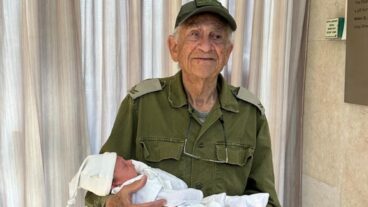Dr. David Jacobs works at his office in Efrat: After a good night’s sleep, I am wide awake when I read scans, x-rays, and MRIs that were done during the night in the United States. At the crack of dawn on a typically gray Cleveland morning, Michael Jones woke up with a bad headache and feeling of confusion. After consulting his doctor, Jones – not his real name – drove himself to the nearest clinic. The technician on duty did an MRI of Jones’ brain which he sent to the radiologist on duty. “It looks like a brain tumor,” he informed the doctor in a telephone conversation.
Dr. David Jacobs, Director of MRI and Neuroradiology at Hillcrest Radiology Associates read the scan and concurred.
“I spoke to the patient, a 70-year old man, and told him I did not want him to drive. I also spoke to the emergency room doctor and arranged for admittance to the hospital in Cleveland,” said Jacobs.
The entire process took only 20 minutes – speedy timing by any diagnostic/admittance standard.
The unique part of this description was that Jacobs was 6000 miles away from the patient, working from his office in Efrat, Israel. Within minutes, the image of the brain was transmitted via sophisticated imaging equipment to Israel, where Jacobs viewed it. The experienced radiologist was ready to call in his report almost immediately. Later, he would fax a written report.
“It gives my colleagues and patients an edge that I moved to Israel,” said Jacobs, during an interview with ISRAEL21c in his high tech office which Jacobs set up in May in the community south of Jerusalem overlooking the picturesque Judean Hills.
The 7-hour time difference between Cleveland and Israel is a boon for the radiology group based in Ohio, Jacobs explained.
“After a good night’s sleep, I am wide awake when I read scans, x-rays, and MRIs that were done during the night in the United States,” says Jacobs, who goes to his office at 6:45 am. “That gives me a clear advantage over a radiologist who has to do a third shift.”
And they are doing three shifts at many labs. Radiologists in the U.S. have been swamped with work in the last ten years. High damage medical lawsuits and the threat of lawsuits have led to an exponential rise in the use of x-rays to minimize diagnostic errors and protect the hospital and its staff.
“Ten years ago, we might have three or four X-rays a night. Now a very large number of people who come into the emergency room are given cat-scans or some sort of radiologic imaging,” said Jacobs. “If you come into an emergency room complaining of a headache, a bellyache, or a cough, there is a very good chance that the doctor on duty will order a cat-scan. This puts enormous pressure on the hospital radiology department which finds it very difficult to cope with the heavy work load.”
Jacobs and partners founded Cleveland’s Hillcrest Radiology Associates, a private company which works in affiliation with Hillcrest Hospital and the Cleveland Clinic Health System in order to meet the demand.
For a year, Hillcrest hooked in to an overseas-based radiology group to reap the time zone benefit. But, according to Jacobs, this became too costly. Since he and his wife Sari had been talking about going on aliyah to Israel, he suggested the idea to his partners.
“I can give the same nighttime service from Israel,” he said.
After some research, the group decided that this was a good business idea, and in fact recruited other radiology groups to use the nighttime service. Jacobs opened his office in May, naming the new venture, “Night Vision.” He likes the name despite one mistaken phone call -from someone looking for a nightscope for his rifle.
Jacobs, 41, a graduate of Albert Einstein Medical School, had moved to Cleveland more than 10 years ago to complete a fellowship in neuroradiology. He is also an expert in intervential radiology – including procedures such as angioplasty, biopsies. “The patient leaves with only a bandage,” he said.
Jacobs credits new technology that has made it possible to take advantage of time zones differences. “In the US, radiology is going filmless. Digital imaging makes it possible for a trained radiologist to see the image although he or she is far from the patient.”
Jacobs also points out some of the other high tech equipment in his office. “We had to set up a broadband connection so that we could send data rapidly overseas.”
The office also has a firewall for top security protection. It complies with HIPPA rules, including the special privacy rule passed in April, which states that every piece of a patient’s medical record has to be protected. Even the fax machine is the latest state of the art – with a voice recognition feature.
Jacobs appreciates the digital powers, but also keeps up a personal connection. “I still like to call every morning. Sometimes I ask for the patient to come back because I didn’t get enough images, or need to see a diffferent angle.”
To operate or not to operate was a question recently dealt with by an emergency room doctor when a woman came in with lower abdominal pain. Looking at the image, Jacobs saw a mild bowel obstruction. The ER doctor in the Kaiser Medical Center, Dr. Y. Glick asked to talk consult with him.
“It was 5 a.m. in Cleveland. I was trying to decide between surgery or observation. After talking to Dr. Jacobs, I decided to admit the woman for observation,” said. Glick. “Dr. Jacobs was easily accessible. I knew that he had vast experience, and his opinion helped me to make my decision.”
Looking out of his Efrat window on a sunny day in the Judean Hills, Jacobs summed up his own personal conclusion: “the bottom line is that the system is working.”












